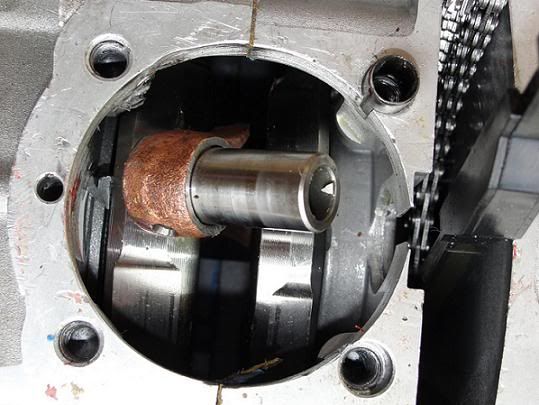Clinician

Currently Offline
Posts: 38
Likes: 0
Joined: Jul 15, 2012 20:06:31 GMT -6
|
Post by Moat on Aug 20, 2012 21:31:36 GMT -6
SAE 90 and 85w-90 are essentially the same... the "85w" in "85w-90" just means that it's a multi-viscosity oil, and acts like an 85 weight oil at 32 degress F - the cold temperature rating that's denoted by the "w". At 212 degrees F (the hot temp rating), it acts just like a single-grade 90 weight oil. www.substech.com/dokuwiki/doku.php?id=gear_oils#viscosity_of_gear_oils Bob |
|
Clinician

Currently Offline
Posts: 38
Likes: 0
Joined: Jul 15, 2012 20:06:31 GMT -6
|
Post by Moat on Aug 8, 2012 14:03:43 GMT -6
Little contradiction there don't you think: the builder most likely left out a case locating pin. Maybe they did not come with alignment pins. "Most"? Umm... not quite what I said. The GY6 parts illustrations I've seen always show two locating dowel pins between case halves, FWIW. Just a thought, another possibility is all... |
|
Clinician

Currently Offline
Posts: 38
Likes: 0
Joined: Jul 15, 2012 20:06:31 GMT -6
|
Post by Moat on Aug 8, 2012 11:32:56 GMT -6
it is IMO that the case was not machine right I still don't understand how someone could come to that conclusion, with so little information presented. In this re-posted pic below, note the relatively even offset/mis-match of the case bore halves - the LH side being higher than the right. Isn't it just as (err... more?) likely that the builder left out a case locating dowel pin, and the case halves torqued out of alignment under load?  There are plenty of unanswered possibilities behind this failure, and no reason to jump to conclusions yet, IMO. |
|
Clinician

Currently Offline
Posts: 38
Likes: 0
Joined: Jul 15, 2012 20:06:31 GMT -6
|
Post by Moat on Aug 7, 2012 20:18:29 GMT -6
to clarify what I was trying to say... OK noday - I now see what you mean. The comparative clearances look quite close, but as you elude to - it's impossible to say, without careful measurement. And the case's threaded stud holes are clearly smaller diameter than the cylinder's stud pass-thru holes, so... hard to compare from here. You'd/we'd have to have been there, I guess...  But again, regardless - if the cylinder slipped easily into the case bore like it should (with clearance between liner and case), it's completely a non-issue. And, conversely, if the builder had to force it on - he should have pulled it back apart to find out why. Too late now. |
|
Clinician

Currently Offline
Posts: 38
Likes: 0
Joined: Jul 15, 2012 20:06:31 GMT -6
|
Post by Moat on Aug 7, 2012 17:16:36 GMT -6
there is more metal between the stud holes and bore hole on the side opposite the cam chain passage. Look closely - the R/H stud holes are bored larger to accommodate the the R/H stud's locating dowels, only installed on that side. Optical illusion... just looks that way. because the liner has very thin metal in the skirt, the skirt deformed at assembly. How could the liner deform if it's not in contact with the case bore? Again... they are not meant to come into any significant contact - if they did, during assembly - the builder should have backed off and figured out why things were not fitting together properly. He'll have to chime in here and describe if he had to force the cylinder onto the case. |
|
Clinician

Currently Offline
Posts: 38
Likes: 0
Joined: Jul 15, 2012 20:06:31 GMT -6
|
Post by Moat on Aug 7, 2012 14:53:18 GMT -6
|
|
Clinician

Currently Offline
Posts: 38
Likes: 0
Joined: Jul 15, 2012 20:06:31 GMT -6
|
Post by Moat on Aug 7, 2012 14:23:59 GMT -6
i agree it seems like it was not bored together. I agree too, but it really makes no difference. The case is bored to clear the cylinder liner - it's not machined to any kind of close tolerance fit, in order to support the portion of the liner that extends into the case bore. IOW - you could hack it out with a hacksaw, and it really wouldn't matter. One proof of that being GY6 case halves are commonly available separately - as entirely separate parts, with no need of being machined as a "matched" set (unlike horizontally split motorcycle cases, where the bearing bores are close-tolerance machined in one pass, as a set). Such precision tolerances are impossible when manufactured like that (separately) - yet it's SOP for the GY6 makers. www.partsforscooters.com/164-151_GY6_Right_crankcase?sc=2&category=124367www.partsforscooters.com/164-150_GY6_Left_Crankcase?sc=2&category=124367You guys are barking up the wrong tree, IMO. I think a more realistic assumption would be that paper-thin cylinder liner was bumped during shipping/handling, and had a hairline crack that went unnoticed during assembly - letting go as soon as the OP ran it under load. |
|
Clinician

Currently Offline
Posts: 38
Likes: 0
Joined: Jul 15, 2012 20:06:31 GMT -6
|
Post by Moat on Aug 5, 2012 8:29:39 GMT -6
I hafta' agree with monsterGY6 - it's impossible to decipher from the provided pics so far, whether or not the case boring (doubtful) or cylinder mating surface (possible) had anything to do with the failure. We'd need more/better close-up pics - preferably with a back-lit straightedge across the surface - to be able to tell anything definitive from this distance.
And yes - that cylinder liner looks to be way, waay too thin to me - wouldn't doubt that as being the failure source.
Bob
|
|

